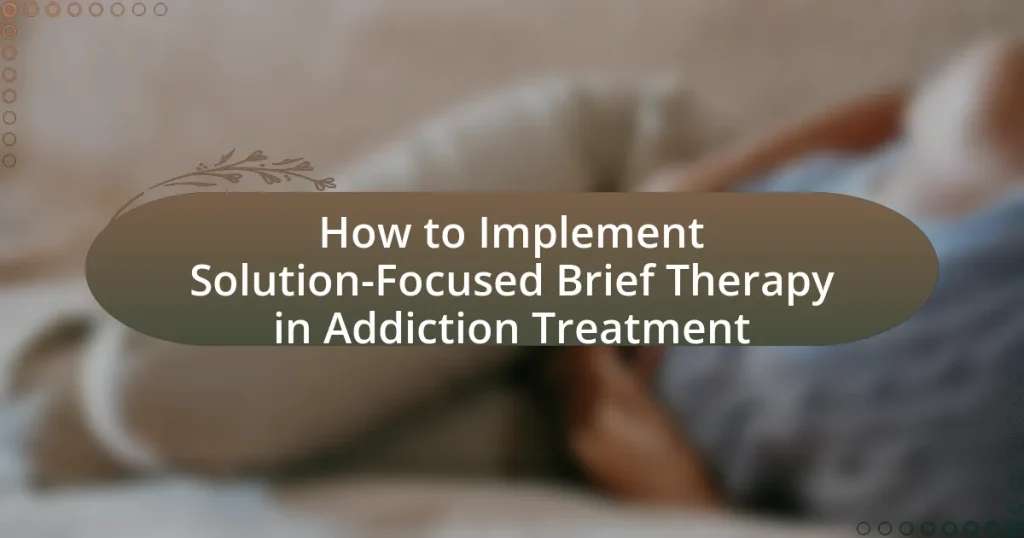Solution-Focused Brief Therapy (SFBT) is a therapeutic approach in addiction treatment that prioritizes solutions and future possibilities over past problems. This article outlines the principles and techniques of SFBT, highlighting its effectiveness in enhancing client motivation and self-efficacy, which are essential for recovery. Key components include goal-setting, the use of scaling questions, and fostering a collaborative therapeutic relationship. The article also addresses challenges practitioners may face when implementing SFBT and offers strategies for overcoming resistance and maintaining client engagement, ultimately demonstrating how SFBT can lead to improved treatment outcomes in addiction recovery.

What is Solution-Focused Brief Therapy in Addiction Treatment?
Solution-Focused Brief Therapy (SFBT) in addiction treatment is a therapeutic approach that emphasizes solutions and future possibilities rather than focusing on problems and past issues. SFBT operates on the premise that clients possess the resources and strengths necessary to overcome their addiction, and it aims to help them identify and utilize these strengths to achieve their goals. Research indicates that SFBT can lead to significant improvements in clients’ motivation and self-efficacy, which are crucial for successful addiction recovery. Studies have shown that clients who engage in SFBT report higher levels of satisfaction and better outcomes in their treatment journey, highlighting its effectiveness in addressing addiction issues.
How does Solution-Focused Brief Therapy differ from traditional addiction treatments?
Solution-Focused Brief Therapy (SFBT) differs from traditional addiction treatments primarily in its focus on solutions rather than problems. While traditional addiction treatments often emphasize understanding the underlying issues and the history of addiction, SFBT concentrates on identifying and amplifying the client’s strengths and resources to create positive change. This approach is typically shorter in duration, aiming for rapid progress by setting specific, achievable goals and exploring past successes, which contrasts with the longer-term, often more intensive nature of traditional therapies that may involve extensive exploration of the client’s past and emotional struggles. Research indicates that SFBT can lead to significant improvements in client outcomes, demonstrating its effectiveness in fostering resilience and self-efficacy in individuals facing addiction.
What are the key principles of Solution-Focused Brief Therapy?
The key principles of Solution-Focused Brief Therapy (SFBT) include a focus on solutions rather than problems, the belief in client strengths and resources, and the use of goal-setting to create a clear vision of the desired future. SFBT emphasizes that clients are capable of change and that small steps can lead to significant progress. This approach encourages clients to identify exceptions to their problems and to envision their preferred future, which helps in formulating actionable steps toward achieving their goals. Research indicates that SFBT is effective in various settings, including addiction treatment, as it fosters a positive and collaborative therapeutic relationship that empowers clients to take control of their recovery process.
How does the focus on solutions impact the treatment process?
The focus on solutions significantly enhances the treatment process by promoting a positive mindset and encouraging client engagement. This approach shifts attention from problems to potential solutions, which fosters motivation and empowers clients to envision their recovery. Research indicates that solution-focused brief therapy (SFBT) can lead to quicker progress in treatment outcomes, as clients are more likely to actively participate when they see a clear path forward. For instance, studies have shown that SFBT can reduce treatment duration while maintaining effectiveness, demonstrating its efficiency in addiction treatment settings.
Why is Solution-Focused Brief Therapy effective for addiction treatment?
Solution-Focused Brief Therapy (SFBT) is effective for addiction treatment because it emphasizes clients’ strengths and resources rather than their problems. This approach fosters a positive mindset, encouraging individuals to envision their desired future and identify steps to achieve it. Research indicates that SFBT can lead to significant improvements in clients’ motivation and self-efficacy, which are crucial for overcoming addiction. A study published in the “Journal of Substance Abuse Treatment” found that clients who engaged in SFBT reported higher levels of satisfaction and lower substance use compared to traditional therapies, demonstrating its efficacy in promoting recovery.
What evidence supports the effectiveness of Solution-Focused Brief Therapy?
Solution-Focused Brief Therapy (SFBT) has demonstrated effectiveness through various studies and meta-analyses. Research by Kim (2008) in the “Journal of Family Therapy” found that SFBT significantly improved client outcomes in diverse settings, including addiction treatment, with effect sizes ranging from moderate to large. Additionally, a meta-analysis by Franklin et al. (2013) in “Psychotherapy: Theory, Research, Practice, Training” reported that SFBT is effective in reducing symptoms of depression and anxiety, which are often comorbid with addiction issues. These findings provide strong evidence supporting the efficacy of SFBT in addressing addiction-related challenges.
How does this approach empower clients in their recovery journey?
This approach empowers clients in their recovery journey by fostering a strengths-based perspective that emphasizes their existing resources and capabilities. Solution-Focused Brief Therapy (SFBT) encourages clients to identify and build upon their past successes, which enhances their self-efficacy and motivation to change. Research indicates that focusing on solutions rather than problems can lead to quicker and more sustainable recovery outcomes, as clients feel more in control and capable of managing their challenges. By actively involving clients in setting achievable goals and recognizing their progress, SFBT cultivates a sense of agency that is crucial for long-term recovery.

How can practitioners implement Solution-Focused Brief Therapy in addiction treatment?
Practitioners can implement Solution-Focused Brief Therapy (SFBT) in addiction treatment by focusing on clients’ strengths and resources to envision and achieve their desired outcomes. This approach involves setting specific, achievable goals and exploring past successes to build confidence and motivation. Research indicates that SFBT can effectively reduce substance use and improve treatment engagement, as evidenced by a study published in the Journal of Substance Abuse Treatment, which found that clients reported significant improvements in their motivation and coping strategies after SFBT sessions. By utilizing techniques such as the miracle question and scaling questions, practitioners can facilitate discussions that empower clients to identify solutions and take actionable steps toward recovery.
What are the essential steps for implementing Solution-Focused Brief Therapy?
The essential steps for implementing Solution-Focused Brief Therapy (SFBT) include establishing a collaborative relationship, identifying client goals, exploring exceptions to problems, and developing a concrete action plan. Establishing a collaborative relationship involves building trust and rapport with the client, which is crucial for effective therapy. Identifying client goals focuses on what the client wants to achieve rather than the problems they face, allowing for a positive direction in therapy. Exploring exceptions involves discussing times when the problem did not occur, which helps clients recognize their strengths and resources. Finally, developing a concrete action plan outlines specific steps the client can take to move toward their goals, reinforcing a sense of agency and empowerment. These steps are supported by research indicating that SFBT is effective in various contexts, including addiction treatment, where goal-oriented approaches can lead to significant improvements in client outcomes.
How do practitioners establish a collaborative relationship with clients?
Practitioners establish a collaborative relationship with clients by actively engaging in open communication and fostering trust. This involves practitioners demonstrating empathy, listening attentively to clients’ concerns, and validating their experiences, which creates a safe environment for dialogue. Research indicates that effective collaboration enhances treatment outcomes, as evidenced by a study published in the Journal of Substance Abuse Treatment, which found that clients who felt heard and understood were more likely to adhere to treatment plans and report positive changes.
What techniques are used to identify client strengths and resources?
Techniques used to identify client strengths and resources include solution-focused questioning, scaling questions, and the use of exception finding. Solution-focused questioning encourages clients to articulate their goals and past successes, which helps in recognizing their strengths. Scaling questions allow clients to evaluate their confidence and progress on a numerical scale, providing insight into their perceived resources. Exception finding involves exploring times when the client was able to cope or succeed despite challenges, highlighting their inherent strengths and available resources. These techniques are effective in fostering a positive therapeutic environment and empowering clients in addiction treatment.
What challenges might practitioners face when implementing this therapy?
Practitioners may face several challenges when implementing Solution-Focused Brief Therapy (SFBT) in addiction treatment, including resistance from clients, limited training in SFBT techniques, and the need for a shift in therapeutic mindset. Resistance from clients can stem from their entrenched behaviors and skepticism about the effectiveness of brief therapy approaches, which may hinder engagement. Additionally, many practitioners may not have received adequate training in SFBT, limiting their ability to apply its principles effectively. Furthermore, SFBT requires a shift from traditional problem-focused approaches to a strengths-based perspective, which can be difficult for practitioners accustomed to more conventional methods. These challenges can impact the overall effectiveness of SFBT in addiction treatment settings.
How can practitioners overcome resistance from clients?
Practitioners can overcome resistance from clients by employing empathetic communication and building rapport. Establishing a trusting relationship allows clients to feel understood and valued, which can reduce defensiveness. Techniques such as active listening, validating feelings, and reflecting on clients’ concerns can facilitate openness. Research indicates that a strong therapeutic alliance significantly enhances treatment outcomes, as evidenced by a study published in the Journal of Consulting and Clinical Psychology, which found that clients who perceive their therapists as empathetic are more likely to engage in the therapeutic process.
What strategies can be employed to maintain client engagement?
To maintain client engagement in addiction treatment using Solution-Focused Brief Therapy (SFBT), therapists can employ strategies such as setting clear goals, utilizing scaling questions, and fostering a collaborative therapeutic relationship. Setting clear goals helps clients visualize their progress and stay motivated, as evidenced by research indicating that goal-setting enhances treatment outcomes (Locke & Latham, 2002). Utilizing scaling questions allows clients to assess their feelings and progress on a numerical scale, which promotes self-reflection and accountability. Additionally, fostering a collaborative therapeutic relationship encourages open communication and trust, essential components for client engagement, as supported by studies showing that strong therapeutic alliances lead to better treatment adherence (Horvath & Symonds, 1991).

What specific techniques are utilized in Solution-Focused Brief Therapy for addiction treatment?
Solution-Focused Brief Therapy (SFBT) for addiction treatment utilizes specific techniques such as the Miracle Question, Scaling Questions, and Exception-Finding Questions. The Miracle Question encourages clients to envision a future without their addiction, helping them identify goals and desired outcomes. Scaling Questions allow clients to assess their progress and feelings on a scale, facilitating self-reflection and motivation. Exception-Finding Questions prompt clients to recall times when their addiction was less problematic, reinforcing their strengths and resources. These techniques are effective in fostering a positive mindset and empowering clients to take actionable steps toward recovery.
How do goal-setting techniques enhance the therapy process?
Goal-setting techniques enhance the therapy process by providing clear objectives that guide both the therapist and the client towards measurable outcomes. These techniques facilitate focus on specific, achievable goals, which can increase motivation and engagement in the therapeutic process. Research indicates that goal-setting improves client outcomes by fostering a sense of ownership and accountability, as clients are more likely to commit to their treatment when they have defined targets to work towards. For instance, a study published in the Journal of Consulting and Clinical Psychology found that clients who set specific goals experienced greater improvements in their mental health compared to those who did not engage in goal-setting.
What types of goals are most effective in addiction treatment?
The most effective types of goals in addiction treatment are specific, measurable, achievable, relevant, and time-bound (SMART) goals. These goals facilitate clear direction and accountability, which are crucial in the recovery process. Research indicates that setting SMART goals enhances motivation and commitment among individuals in treatment, leading to better outcomes. For instance, a study published in the Journal of Substance Abuse Treatment found that clients who set specific and measurable goals were more likely to achieve significant reductions in substance use compared to those who did not.
How can practitioners assist clients in tracking their progress?
Practitioners can assist clients in tracking their progress by implementing structured assessment tools and regular feedback sessions. These methods enable clients to visualize their advancements and identify areas needing improvement. For instance, using standardized questionnaires or progress charts allows clients to quantify their achievements, while feedback sessions foster open communication about their experiences and challenges. Research indicates that regular monitoring and feedback can enhance motivation and accountability, leading to better treatment outcomes in addiction therapy.
What role do scaling questions play in Solution-Focused Brief Therapy?
Scaling questions in Solution-Focused Brief Therapy (SFBT) serve to help clients assess their current situation and progress toward their goals. These questions typically ask clients to rate their feelings or experiences on a scale, often from 0 to 10, which facilitates a concrete understanding of their progress and challenges. For instance, a client might be asked to rate their confidence in overcoming addiction, allowing both the therapist and client to identify specific areas for improvement and celebrate small successes. Research indicates that scaling questions enhance client engagement and self-efficacy, making them a vital tool in the therapeutic process.
How can scaling questions help clients assess their readiness for change?
Scaling questions help clients assess their readiness for change by providing a quantifiable measure of their current state and desired outcomes. These questions encourage clients to rate their feelings or confidence on a scale, typically from 0 to 10, which facilitates self-reflection and clarity regarding their motivation and commitment to change. For instance, a client might be asked to rate their readiness to quit substance use, allowing them to articulate specific barriers and strengths associated with their decision. This method is supported by research indicating that scaling questions enhance self-efficacy and promote goal-setting, as evidenced in studies on solution-focused brief therapy, which highlight the effectiveness of such techniques in fostering client engagement and progress in addiction treatment.
What insights can scaling questions provide during therapy sessions?
Scaling questions can provide valuable insights into a client’s perception of their progress and challenges during therapy sessions. These questions help clients quantify their feelings or experiences on a scale, often from 0 to 10, allowing them to articulate their current state and desired outcomes more clearly. For instance, a client might rate their motivation to change as a 4 out of 10, which indicates room for improvement and opens a dialogue about what factors contribute to their current rating. This method not only facilitates self-reflection but also enables therapists to track changes over time, making it easier to identify patterns and shifts in the client’s mindset. Research indicates that scaling questions can enhance client engagement and foster a sense of ownership over their therapeutic journey, ultimately leading to more effective treatment outcomes in addiction therapy.
What are some best practices for practitioners using Solution-Focused Brief Therapy?
Practitioners using Solution-Focused Brief Therapy (SFBT) should prioritize goal-setting, emphasizing clients’ strengths and resources. This approach involves collaboratively defining clear, achievable goals with clients, which enhances motivation and focus during therapy sessions. Additionally, practitioners should utilize scaling questions to help clients assess their progress and identify small steps toward their goals. Research indicates that SFBT is effective in various settings, including addiction treatment, as it fosters a positive outlook and encourages clients to envision their desired future, thereby facilitating change.
How can practitioners create a supportive environment for clients?
Practitioners can create a supportive environment for clients by fostering open communication, demonstrating empathy, and establishing trust. Open communication allows clients to express their thoughts and feelings without fear of judgment, which is essential in addiction treatment. Demonstrating empathy helps clients feel understood and validated, enhancing their willingness to engage in the therapeutic process. Establishing trust is crucial, as it encourages clients to be honest about their struggles and progress. Research indicates that a supportive therapeutic alliance significantly improves treatment outcomes in addiction recovery, highlighting the importance of these elements in creating a conducive environment for healing.
What ongoing training or resources are recommended for practitioners?
Ongoing training and resources recommended for practitioners implementing Solution-Focused Brief Therapy (SFBT) in addiction treatment include workshops, online courses, and professional supervision. Workshops such as those offered by the Brief Therapy Institute provide hands-on experience and practical skills in SFBT techniques. Online platforms like the International Center for Solution-Focused Training offer courses that practitioners can complete at their own pace, enhancing their understanding of SFBT principles. Additionally, engaging in professional supervision allows practitioners to discuss cases and receive feedback, which is crucial for skill development. Research indicates that continuous education in therapeutic techniques significantly improves treatment outcomes, making these resources essential for effective practice in addiction treatment.
